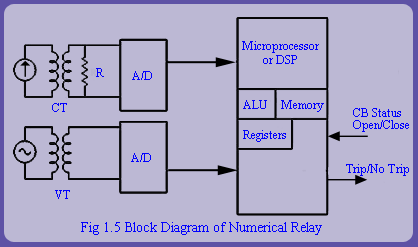| |
With the advent of transistors, operational amplifiers etc, solid state relays were developed. They realize the functionality through various operations like comparators etc. They provide more flexibility and have less power consumption than their electromechanical counterpart. A major advantage with the solid state relays is their ability to provide self checking facility i.e. the relays can monitor their own health and raise a flag or alarm if its own component fails. Some of the advantages of solid state relays are low burden, improved dynamic performance characteristics, high seismic withstand capacity and reduced panel space.
Relay burden refers to the amount of volt amperes (VA) consumed by the relay. Higher is this value, more is the corresponding loading on the current and voltage sensors i.e. current transformers (CT) and voltage transformers (VT) which energizes these relays. Higher loading of the sensors lead to deterioration in their performance. A performance of CT or VT is gauged by the quality of the replication of the corresponding primary waveform signal. Higher burden leads to problem of CT saturation and inaccuracies in measurements. Thus it is desirable to keep CT/VT burdens as low as possible.
These relays have been now superseded by the microprocessor based relays or numerical relays. |
| |
 |
|
The block diagram of a numerical relay is shown in fig 1.5.
It involves analog to digital (A/D) conversion of analog voltage and currents obtained from secondary of CTs and VTs. These current and voltage samples are fed to the microprocessor or Digital Signal Processors (DSPs) where the protection algorithms or programs process the signals and decide whether a fault exists in the apparatus under consideration or not. In case, a fault is diagnosed, a trip decision is issued. Numerical relays provide maximum flexibility in defining relaying logic. |